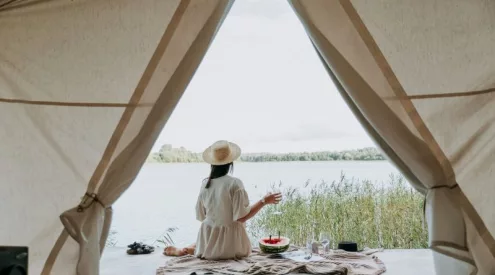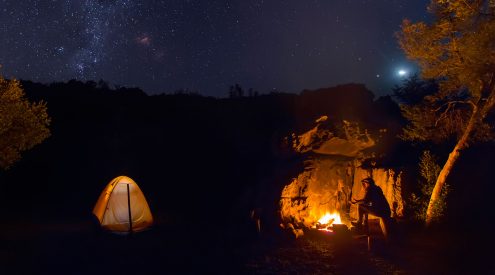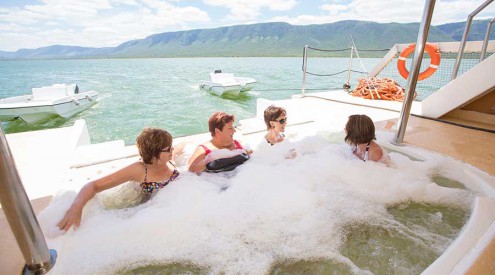“It is a wol,” Safari James informed me.
“Giant Eagle Owl?” I persisted, in a tone that was part polite question and part annoyance. I’d just about had enough of Safari James (so named as there was a tourist James, a friend of ours, sitting next to Safari James in the latter’s quintessentially East African minivan with a pop-up viewing roof).
“No, wol.”
I felt like screaming. OK, there was a difference in accents – I’m Australian and Safari James was Kenyan. I can’t criticize a guy for his grasp of a second language, but even once we’d agreed that ‘wol’ was the same as ‘owl’, there was no more info forthcoming from our safari guide.
I’m not a pedant, but if Safari James had added something other than ‘wol’ to his bird identification, such as, perhaps the bird’s correct name – Verreaux’s Eagle Owl – I might have been prepared to cut him some slack.
There were seven guests in the van – myself and six friends – and while I am certainly not a bird fundi (I hardly qualify as a keen amateur) I was having to identify some very common birds for us all, including our guide. It was embarrassing.
The first bird Safari James identified was a “Supreme Starling”. A beautiful creature, to be sure – glossy back and red-brown underpants with a splash of white – and I’d never seen one. And nor could I find it in the new bird book I’d bought. After a bit of searching, though, I found the Superb Starling.
And so it went on. The ‘roller’ (no more information forthcoming) was a European Roller; the ‘Goshawk’ (again, nothing more) turned out to be a Brown Snake Eagle (I couldn’t believe that one), and after much to-ing and fro-ing I was able to win an argument with S.J. that the Tawny Eagle in the tree was actually a Black Chested Snake Eagle.
I’m not trying to be smart, but one thing I have come to expect when I pay money to go on a game drive in southern Africa – South Africa in particular – is that my guide will be smarter than me when it comes to birds and animals.
To rewind, a little, I’ve just finished a brief visit to Tsavo East National Park in Kenya, following five lovely nights lazing around Nyali Beach, Mombasa. I’m at Mombasa airport as I write this, trying to come to terms with the difference between traveling in East and Southern Africa.
I’m on a mission to decide if East Africa is actually worth it as a game viewing destination.
If you glance at any travel website offering safaris to East Africa you’ll soon work out it’s expensive. Granted, there are plenty of expensive safari destinations in southern Africa as well, but you can also travel to most of that part of Africa’s game viewing meccas on the cheap, on a self-drive holiday.
Not so, Tsavo East – or any of Kenya or Tanzania’s national parks. Although Tsavo – comprising Tsavo East and Tsavo West – is huge, it’s not nearly as well known as its comparatively tiny Kenyan cousin, the Masai Mara.
I wasn’t expecting to see millions of wildebeests hopping across crocodiles’ scaly backs to get to the other side or the river, or the cast of the Big Cat Diaries. The reason nobody bothers to claim Tsavo is a wildlife Eden (whatever that means) is because it isn’t.
For that reason, a safari to Tsavo East is cheaper than a visit to the Masai Mara. For US$290 per person per night we found an operator who would transfer our party of seven from our hotel at Mombasa the 200-or-so kilometres to Tsavo East, and then give us a 24-hour safari experience (lunch on arrival, an afternoon game drive, dinner, a morning game drive, breakfast, then a trip back to the beach).
I’d considered hiring a car and driving to Tsavo East from Mombasa, but as our group’s numbers grew the thought of hiring two vehicles and navigating everyone there and back started to lose its appeal. To stay at the camp we’d chosen, Satao Camp, would have cost us US$130 a person per night anyway, plus entry fees of US$50 per person per day, and a US$25 vehicle entry fee.
Any lingering thoughts I might have had about driving myself and saving a few bob went out the window a few minutes after Safari James picked us up in his bus and threw himself into the maelstrom of Mombasa’s peak hour traffic.
Frustration at the hour-plus traffic jam we sweltered through turned to sheer terror once we cleared the city and hit the main Mombasa-Nairobi highway. As a road, it’s pretty good – wide tar with hardly a pothole in sight. It’s not the road that’s crap, just Kenyan drivers.
For a very short while Safari James seemed to be on his best behaviour, chugging patiently along behind slow moving lorries laden with shipping containers from Mombasa port. He would ‘tsk tsk’ dutifully and ease over to the verge as a Matatu (the local name for a minibus taxi) screamed down the wrong side of the road towards us.
But after half an hour or so Safari James could no longer resist the urge to drive fast, honk his horn and try and kill himself and all his passengers. Too worried (like the rest of us) to even feign sleep, Non-Safari James, sitting in the front passenger seat, resorted to desperate measures to avoid having to look out the windscreen, busying himself reading the instruction book for his new camera.
The highway resembled the road from Baghdad Airport to the Green Zone – charred and smoking hulks of vehicles, dazed survivors stumbling in the burned grass, ambulances arriving too late…
I saw a container lying on its side, doors open, with the contents burning inside. Who was waiting for that stuff? How long had they been waiting? I didn’t want to think about what had happened to the driver – the prime mover was twisted and burned beyond recognition.
Safari James’ accelerator foot barely had time to rest as we waited for him to complete the entry formalities at Tsavo East’s Buchema Gate. Buchema is a local word meaning place where aggressive touts sell floppy safari hats.
The gate opens… gentlemen, start your engines. The only people driving faster than the safari buses entering Tsavo were those on their way out. The Ferrari Safari was just moving into top gear.
Safari James switched on a very loud two-way radio that blared, non-stop, at top volume for the next 24 hours. Someone, somewhere out there was chatting excitedly about something.
I can recognise some animal names in Shangaan and Shona, but I know no Swahili, so I have no idea what all these excited tour guides were spotting. Neither did Safari James, for all the good it did him.
We zoomed from one non-descript piece of Tsavo bush to another, in search of who-knows-what. On the way to wherever it was he felt he needed to drive at 80 kilometres per hour we did manage to see elephant, zebra, gemsbok (oryx), Grant’s gazelle, impala, Masai Giraffe and some form of Hartebeest (Safari James didn’t seem particularly phased about narrowing the identification any further than that).
There was no information, other than the animal’s name, provided at any of these sightings. Armed with an East African mammal identification book I could have done better myself… and that was a real shame. I was ready to learn and the questions I asked (while I could still be bothered), were met with mute smiles and shakes of the head.
The countryside was interesting and some recent rains had turned Tsavo’s famed red dust to red mud, which provided an interesting coating of, well, red, to every animal we saw, including a very cute trio of warthog piglets.
I thought the countryside was nice. It seemed pretty open – a bit like the plains around Satara, in Kruger – but my friend non-Safari James said it was nothing like the Masai Mara and Serengeti (where he’d been a couple of times before), which were more like mown lawns, apparently. Unlike Tsavo, he assured me, my next stop – the Serengeti – would be teeming with game.
Truthfully, it didn’t bother me that I didn’t see any big cats. I can honestly say I’ve spent enough time in the African bush to just appreciate being there… and in this case being somewhere different.
However, I don’t think I’ll ever be going back to Tsavo. If I’m going to have to work hard to find game and learn about birds I’d rather be paying the self-drive, self-catering rates in Kruger rather than spending a small fortune on a ‘budget’ guided option in Kenya.
On the bright side, I did get to see a wol.
Next stop… Tanzania’s Ngorongoro Crater.

















